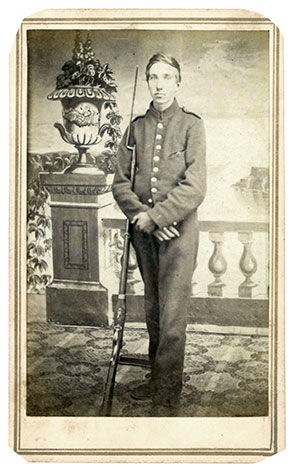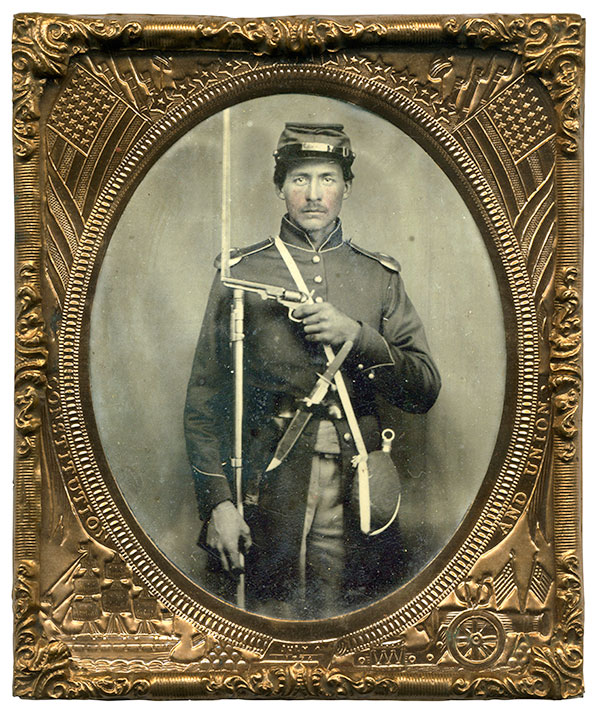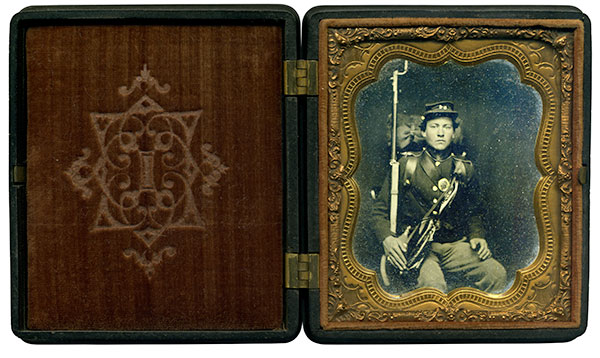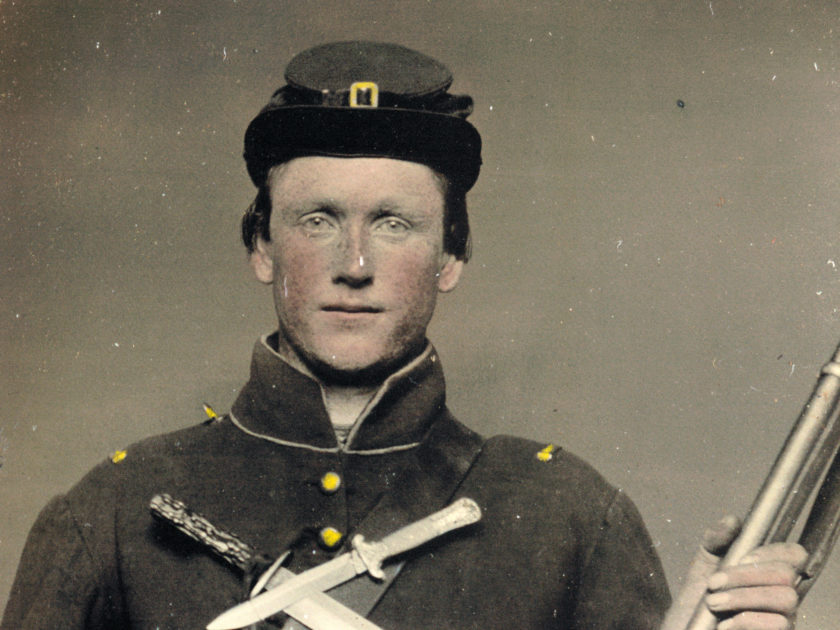By Katelyn Brown
Few people would dispute the accepted fact that battlefield photographers of the Civil War sometimes included props—even human beings—in their photographs.

Alexander Gardner famously moved corpses in his photographs at Gettysburg, and Thomas C. Roche posed his black assistant in several shots around Petersburg. As this was common practice in the field, who is to say that the studio portrait of the fierce-looking Civil Warrior armed to the teeth did not include props? While obvious instances of props used in the studio exist, such as the sign that proclaims “Jeff Davis and the South!” seen in several photographs in the Liljenquist Collection at the Library of Congress, a more challenging question to analyze involves the use of weapons as props.
Although virtually no literary evidence has come to light proving the use of weapons as props in the studio, one can reasonably conclude that they were employed.
Though a few collectors dismiss the concept of prop weapons as purely urban legend, some portraits appear to incorporate them. One example is the Bowie knife. These knives would have been practical for little more than hand-to-hand combat. Other instances include men armed with five or six guns, which would have proved too cumbersome to carry into a fight.
Still, further sources suggest that big knives and multiple guns were not necessarily props. Considerable evidence exists that whole regiments of volunteers in New England were gifted revolvers and knives by grateful hometown residents before they marched off to war. One can imagine that these fighting implements might have been carried into photographers’ studios.
Once these soldiers were trained and embarked on active campaigns however, they quickly learned to pitch to the wayside all unnecessary items with little tangible value. This may have included knives and revolvers. Some had no choice: In several New England regiments, according to Ron Field in his forthcoming book Rally Round the Flag, the rank and file was ordered to turn in knives and revolvers, which were then stored in a safe place presumably to be returned at some later date.
Despite the added weight and questionable military value, it is also likely that some soldiers hung onto their knives and guns. Those who did use their weapons typically carried their knives in sheaths, and revolvers in a holster or with a cord attached to the stock and carried in a breast pocket. Portraits that show soldiers accoutered with sheaths, holsters and cords suggest that they are not props.
Muskets can be difficult to judge based on appearance alone. Some authorities suggest that the presence or a lack of a strap is significant: Those with straps were more likely to be weapons carried by the soldiers, and those without may have been props because they were cumbersome to carry without them. Others are dismissive of straps because they were only for convenience on the march, and even then, soldiers may have found it easier to carry the musket or rest it on a shoulder.

Another suggestive use of weapons as props includes images of privates that posed with officer swords or obsolete weapons. In his Photography and the American Civil War, Jeff Rosenheim features a portrait of Pvt. George M. Harper of Company A, “Cutt’s Battery,” 11th Battalion, Georgia Volunteer Artillery. Highlighting his poorly fitted jacket, the crooked pin on his kepi and militia officer’s sword, Rosenheim concludes, “Everything the soldier wears or holds is a prop lent to him by a buddy or the photographer.”
The location and time period of a portrait is also important when considering the possibility of a weapon as a prop. Small photography studios likely had little spare money to buy very many prop weapons. The large studios however, would have been able to advertise the availability of props to draw in customers who had a desire to look fierce. At the beginning of the war, when patriotic fervor ran high, soldiers would have wanted to send portraits home to their families. According to Field, “early war regiments often received some elements of uniform and clothing before they got their weapons and accouterments. It would make perfect sense for a hometown photographer to acquire a pistol, sword or saber to help make his military customers look more battle-ready.”

Civil War photograph collector and Curator at the West Point Museum Mike McAfee also referenced a probable use of a weapon as a prop in a portrait of a volunteer from 1861, wearing a New York state militia jacket with a Hall rifle, an obsolete weapon at that time. McAfee observed that, “it was the photographer’s and not the soldier’s weapon.” He strongly encourages anyone who studies portraits that can be linked to a specific regiment to learn which standard-issue weapons and other equipment the soldier received upon his enlistment. In this way, prop weapons can be separated from authentic arms.
This desire to appear menacing in a photograph appears among the writings by the soldiers. The idea of having their picture taken delighted many soldiers, particularly as the occasion provided a chance to show off their new uniforms and equipment. William Wiley of the 77th Illinois Infantry wrote of the soldiers’ excitement during trips to town to have their pictures taken “with acoutraments and musket in hand in the atitude of attention and a revolver and a big knife [in] our belts.” While Wiley’s remark does not answer the question of props or not props, it does suggest that the soldier would go to great lengths to appear military.

The family of Pvt. Chandler B. Gillam, of the 28th New York Infantry, requested that he have his picture taken with “his gun and other military fixings.” Gillam did not possess a gun, and so was unable to send his likeness home. Such writings illustrate how profitable it would have been for photographers to have weapons on hand. If they did, the soldiers of Wiley’s regiment could have piled themselves high with weapons, and Chandler Gillam would not have disappointed his family.
Profitability was also a key factor for Civil War photographers. According to collector David W. Vaughan, photographers at that time “perceived themselves as artists but were first and foremost entrepreneurs,” and would have sought to make money through quality portraits. Just as with the backdrops in studios and staged scenes in the battlefield, the photographer’s goal was an image that combined artistry and drama. The use of prop weapons in the studio would have added flair, and contributed positively in both a monetary and artistic way.
While weapons clearly enhanced the portraits, no definitive evidence exists that photographers supplied arms. Research has not yielded any photographer records or soldier accounts that include information regarding a specific instance where a photographer kept weapons on hand as props. A possibility always exists that the soldiers simply brought their own knives, pistols and swords. They may also have borrowed weapons from each other. Nevertheless, prop weapons were used in at least a few studios. This may not have been a common practice, but it is probable that a clever photographer, with an artistic eye and the spirit of an entrepreneur, employed this tactic with their patriotic, battle-ready customers.




Thanks to photograph collectors Rick Carlile, Ron Field, Mike Medhurst, Robert York, Mike McAfee, David W. Vaughan and Rick Brown who supplied their insight and knowledge on this subject.
References: Ellen C. Collier, Letters of a Civil War Soldier; David Lowe and Philip Shiman, “Substitute for a Corpse,” Civil War Times 49 (2010); Jeffrey L. Rosenheim, Photography and the American Civil War; Terrence J. Winschel, ed., The Civil War Diary of a Common Soldier: William Wiley of the 77th Illinois Infantry.
Katelyn Brown is a senior at Christopher Newport University majoring in American Studies and Economics. She has held archival internships working with historic photographs at the U.S. Department of State and The Mariners’ Museum.
SPREAD THE WORD: We encourage you to share this story on social media and elsewhere to educate and raise awareness. If you wish to use any image on this page for another purpose, please request permission.
LEARN MORE about Military Images, America’s only magazine dedicated to showcasing, interpreting and preserving Civil War portrait photography.
VISIT OUR STORE to subscribe, renew a subscription, and more.

